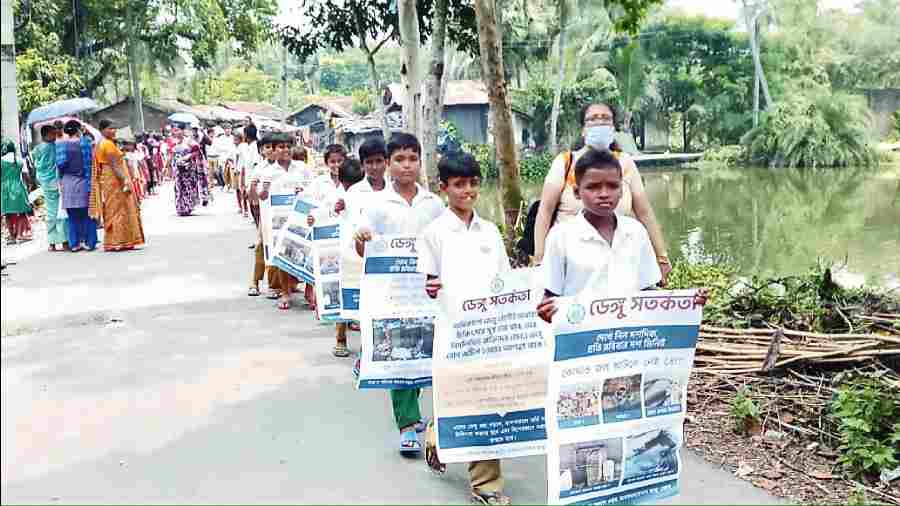The number of dengue cases are rising in rural areas across Bengal and this has led the health department to blame unplanned urbanisation for creating breeding pockets for aedes aegypti mosquitoes, which spreads the vector-borne disease.
In the first week of September, Bengal reported 1,854 dengue cases across the state and 906 of those have been reported from rural areas of the districts with North 24-Parganas, Howrah, Hooghly, Murshidabad, Jalpaiguri and Darjeeling taking the lead.
Among the 1,854 cases reported across Bengal in the first week of September, 1,167 were from these six districts. Pointing to the rise in the number of cases in rural Bengal this year, a health official said in the corresponding week last year the count in these six districts stood at 352.
Health officials and urban experts claim that the rise in the number of dengue cases in rural areas was largely due to rapid urbanization without corresponding urban infrastructure.
“This year we have observed that the number of cases has increased significantly in the rural areas. This is an unusual trend. Although we need to carry out a detailed study, primarily we have reasons to believe that urbanization in rural pockets is a prime reason behind this rise,” said Siddhartha Niyogi, the director of health services in Bengal.
A health official said the rate of dengue causes was multiplying fast and in the second week of September the count in the six districts had increased from 1,167 to over 1,900.
The official added that in a few districts the number of people infected in its rural belt is 60-70 per cent more than its corresponding urban areas.Citing the example of Diamond Harbour, the official said while rural areas of the block reported 150 cases last week, the count was 50 in its urban areas.
Hitting the nail on its head, Saswat Bandyopadhyay, a professor of urban planning at the Centre for Environmental Planning and Technology (CEPT) University in Ahmedabad, said unmanaged solid waste and lack of proper sanitation in rural areas were responsible for the spread of vector-borne diseases.
“Unmanaged solid waste is blocking the sewerage system and leading to the problem of waterlogging in rural and semi-urban areas. As a result, people living in those pockets are facing infections of multiple vector-borne diseases like dengue or chikungunya,” said Bandyopadhyay.
Experts in public health at Swasthya Bhavan pointed out that rural pockets where dengue cases were on the rise had witnessed unplanned urbanization in the past few years but remained under panchayats, which don’t have the infrastructure or funds to monitor sanitation and manage the sewerage system.
According to state health department data, the government has identified 12 blocks, which are rural pockets, across Bengal where dengue cases are rising alarmingly.Lalgola in Murshidabad tops the list by reporting 125 dengue cases in the first week of September. Deprived of civic amenities, people of Lalgola in Murshidabad’s Matigara had already demanded to bring their areas under a civic body because of rapid urbanization happening there.
“The rate of rise in dengue cases is 69 per cent in Lalgola and we don’t know what is waiting for us in near future,” a senior health official in Calcutta said.
Aedes aegypti mosquitoes that are responsible for the rise in dengue cases usually breed in stagnant water that has not been disturbed for at least seven days, a health official said and added that panchayats do not have the mechanism to address issues of sanitation that rises out of urbanisation.
“It is not possible for a panchayat to monitor sanitation regularly as they have no dedicated fund or workforce like municipalities. So, pockets with stagnant water are not cleared and it easily helps aedes aegypti to breed undisturbed,” said a senior official.
Sources in multiple gram panchayats, however, said even though they did not have any dedicated fund for sanitation, the rural bodies used workers under the 100 days’ job scheme for cleanliness drive. Chief minister Mamata Banerjee on Wednesday expressed concern about the rise in dengue cases in Bengal and asked people to keep their areas clean.The scene is the same in parts of north Bengal where rural and hills areas are witnessing a rise in the number of dengue cases. The prevalence of dengue is high in Dudhia, Panighata, Kalijhora, Matigara, Upper Bagdogra, Lower Bagdogra, Gosaipur areas of the foothills and surrounding rural areas of Siliguri city.
(Additional reporting by Binita Paul and Alamgir Hossain)











